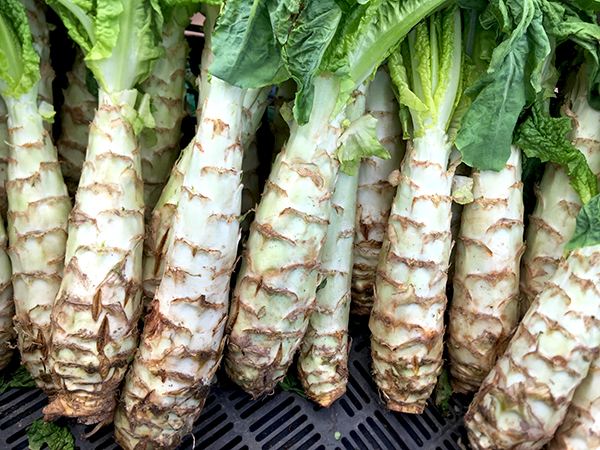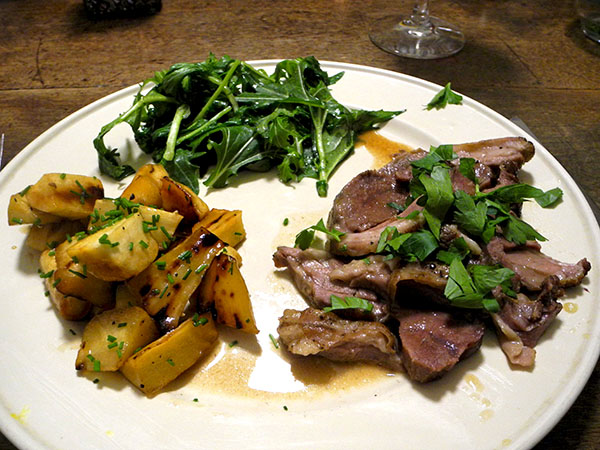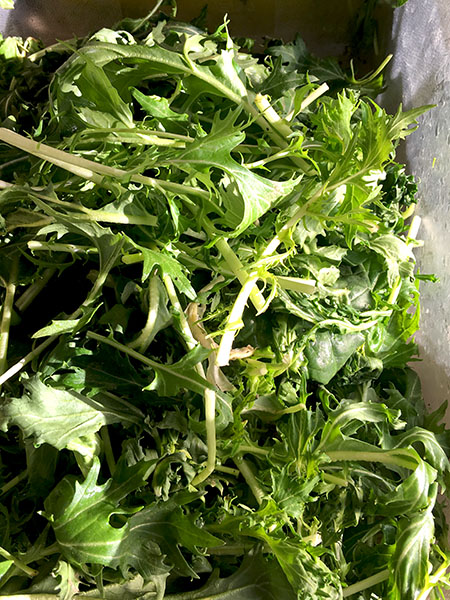
When I spotted Lynn Haven’s stall in the Greenmarket on Wednesday I was reminded that I hadn’t even thought about goat meat in quite a while. After a discussion about what was inside the freezer boxes that day, and a reflection on how much cooking heat I might be able to tolerate in the kitchen on a July night, I decided on one of her tiny racks. I picked the loin, mostly because it looked so perfectly compact, but also because its weight seemed just right for a modest serving of meat for 2 people.
- one goat loin rack (.82 pounds) from Lynn Haven in the Union Square Greenmarket, dry-marinated in the refrigerator for almost 4 hours in a mixture of rosemary leaves from Stokes Farm, removed from their stems; one medium crushed bay leaf from Westside Market; a bit of zest from an organic lemon from Whole Foods Market; a small part of one crushed dried dark habanada pepper; sea salt, and freshly-ground Tellicherry pepper, allowed to sit, covered, inside the refrigerator for a few hours, then brought to room temperature over an hour before ready to be roasted, at which time it was dried with paper towels and coated lightly with olive oil, the oven preheated to 425º and a heavy oval enameled cast iron pan placed inside for 10 minutes, the goat arranged one of its flesh sides down inside the hot pan and roasted in the preheated oven for about 15 minutes (for rare to medium rare doneness), allowed to rest 7 minutes or so, the ribs separated into 4 chops with a heavy knife and arranged on 2 plates, finished with a squeeze of the lemon from which the zest had been removed earlier, drizzled with a bit of olive oil, garnished with ‘Bull’s Blood’ micro beet from Windfall Farms
- four large cherry tomatoes from Alex’s Tomato Farm, in Carlisle, NY, from Chelsea’s Down to Earth Farmers Market, halved, placed cut side down inside the pan from which the goat had just been removed and allowed to begin to soften, turning once, arranged on the plates and sprinkled with Maldon salt and Tellicherry pepper
- two thick stalks of celtuce from Mountain Sweet Berry Farm, the leaves removed from the ‘stalks’ and washed several times, wilted in a bit of olive oil and set aside, then the stalks themselves peeled and cut into discs, briefly par-boiled in a low-sodium vegetable broth, drained, dried, and sautéed in a little olive with a tiny amount of finely-chopped red spring onion stems from Alewife Farm over a moderate flame for a minute or two, then tossed with a sprinkling of pine nuts which had earlier been heated in a cast iron pan until they had begun to brown, the celtuce leaves reserved earlier now gently reheated and distributed onto the plates and the sliced stalks and pine nuts placed aside and a little on top of them

- the wine was a California (Clarksburg) red, David Akiyoshi Reserve Cabernet Sauvignon Clarksburg 2014, from Naked Wines
- the music was a magnificent performance of Schumann’s Symphony No. 2, Yannick Nézet-Séguin conducting the Chamber Orchestra of Europe








